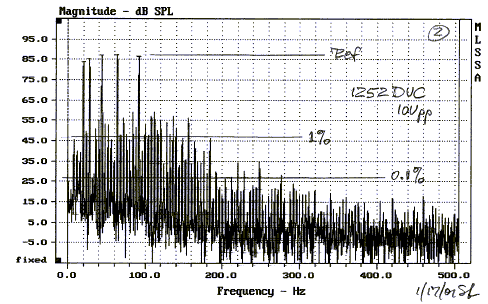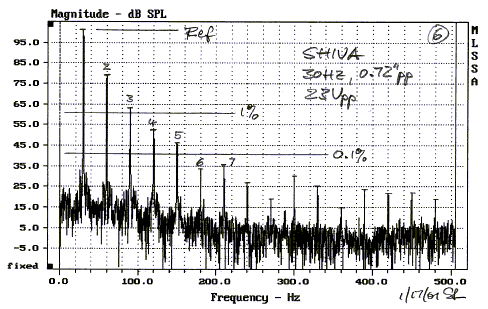|

| Dipole Woofer | FAQ
|
Alternate drivers for the PHOENIX dipole
woofer - 2
As I indicated in FAQ4 I have
been trying to find a large excursion 12" driver that would give me twice
the useable volume displacement as the 1252DVC or X6100 for 6 dB more acoustic
output at about the same level of non-linear distortion. The cabinet size should
increase only marginally and the cost of the driver should not more than
double.
I have come to the conclusion that it is not possible to
obtain this. What is possible, though, are lower distortion at the same
displacement, and about 3 dB more useable output at twice the cost and in a
2.5" wider cabinet than for the 1252DVC or X6100.
The major problem with increased excursion is the
disproportionate increase in aero-dynamic noise. It is generated by the
turbulent flow of air in and out of the magnet vent and by the air trapped
behind the spider if it is not completely vented. The typical, low cost stamped
basket design is not suited for venting the spider. The extraneous noise becomes
especially noticeable in an open baffle speaker, because it contains many high
frequency spectral components and is intermodulated with the desired signal.
One possible lower distortion alternative driver is the
Adire Audio "Shiva". As most
drivers designed for box applications this driver (SHIVA 121947 8ohm, #758) has a low Qts=0.49. In
combination with a higher Fs=26 Hz it causes the response to be down 5 dB at 20
Hz compared to the 1252DVC. The early roll-off could be equalized with a shelving
lowpass filter if deemed necessary.

All measurements on this page are taken at about 1"
in front of the dust cap of the driver without baffle.
A large number of non-linear distortion products, i.e. harmonics and
intermodulation, are generated in response to a 5-tone input signal by both
drivers (spectral contamination). The 5 tones excite the intended woofer
frequency range below 100 Hz. The resulting distortion products occupy a much
wider frequency range and can not be filtered out.
The spectral line density of the
distortion products above the 1% and between the 1% and 0.1% level lines is
quite different for the two drivers.


The Shiva is clearly a lower distortion driver for the
same terminal voltage. This corresponds to the same output level around 60 Hz,
but since the Shiva has less output below this frequency than the 1252DVC, it
also has less total cone excursion. The frequency response would have to be
equalized to match the 1252DVC to make this a complete comparison.
A more conventional harmonic distortion test with a single
30 Hz tone and 0.5" peak-to-peak cone excursion confirms the Shiva's better
performance.


At 0.5"pp the Shiva's distortion looks quite
respectable, especially when the driver arrangement in the PHOENIX woofer gives
an additional reduction of even order distortion products. This would seem to
apply even at 0.72"pp excursion, but now the aero-dynamic distortion takes
over. It does not show up in the measurement in front of the dust cap, but on
the magnet side.

In effect, the turbulence noise limits the useable
excursion. The Shiva can effectively only give about 3 dB more maximum useable
output. If more is needed, then the solution is to go to 4 drivers and a larger
cabinet. Within those limits the Shiva will always give a lower distortion
output than the 1252DVC or X6100 and does represent a worthwhile alternative, if
the slightly larger cabinet and increased cost are not an issue.
The comparison has focused on the Shiva driver, but there
are other 12" drivers of similar construction available which claim
1"pp excursion capability. Unless they have solved the aero-dynamic noise
problem, they will also be limited to less than 1"pp maximum useable excursion
in open baffle applications. It also must not be assumed that their non-linear
distortion behavior at lower excursions is similar to the Shiva's. Only
measurements can tell. To be useable at 1"pp excursion a driver must have,
amongst other things, no dust cap and a fully vented spider, so that no air is
trapped and forced to flow at high velocity through narrow openings with sharp
edges.
The NHT1259 driver
has a response that is almost identical to the 1252DVC except 2 dB lower in
sensitivity. Though it claims Xmax = 13 mm, only 6 mm are useable in open baffle
application due to noise and rapidly increasing distortion. The same applies
also to the Sonicraft SC-1250. Its
sensitivity is 3 dB lower than the 1252DVC. Either driver could be
substituted for the 1252DVC/X6100 in a slightly wider cabinet. It would have the
advantage of lower distortion at the same excursion level as the 1252DVC, but
only marginally higher useable output. If significantly higher SPL levels are
required, then it will take four of either the Shiva, NHT1259, SC-1250 or the
1252DVC/X6100 in a double height PHOENIX style cabinet.
For a higher output alternative see Woofer3.
Dipole woofer cabinet for Shiva size driver


| Dipole Woofer | FAQ
|
|